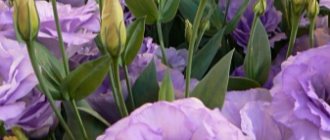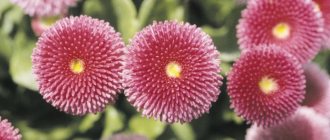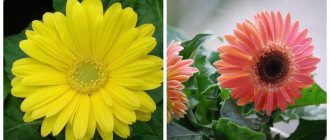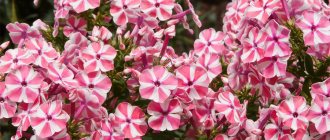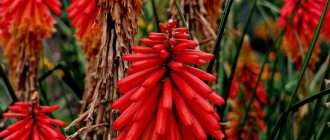What do gerbera flowers look like?
- Gerbera is very similar to chamomile. But unlike the white petals of chamomile, gerbera has a different color
- There are white, scarlet, pink, yellow and other gerberas. Almost all varieties are distinguished by bright colors
- Gerbera belongs to the Aster family, so there are similarities with lush asters
- Low-growing varieties are ideal for growing indoors. However, it is worth noting that the height of the gerbera stem can reach 60 cm
- The diameter of the flowers ranges from 4 to 12 cm
Gerbera indoors
When and how do buds appear?
The flowering period of gerbera is long and lasts almost the entire summer . The flowers grow large in size, resembling daisies or daisies. Simple, terry or semi-double. The beginning of flowering occurs at temperatures from 22 to 28 degrees, with a sufficient level of humidity.
Features of care during this period
For longer and more abundant flowering, you need to remove faded inflorescences, which will promote the formation of new buds. Cut dry stems as low as possible, as the remaining stumps may rot.
Are gerberas perennial or annual?
Important: In open ground, gerberas are grown in greenhouses. Constant changes in climatic conditions are not acceptable for this plant. Indoor gerberas live much longer.
Gerbera can be an annual or perennial plant. If we are talking about open ground, then gerberas can please the eye only for one year - in the summer. In winter, the roots must be dug up and placed in a basement with a suitable temperature. In this case, there should be an earthen lump on the roots. This is the only way the roots can survive.
Indoor gerbera is a perennial plant. The plant will live a long time if you take proper care
Types and varieties of gerbera
Information about the types and varieties of Transvaal chamomile varies - according to some sources there are from 40 to 90. Every year, amateur breeders grow new varieties, hybridize and cross-breed known ones.
One of the plant classifications is based on external characteristics:
- multi-flowered;
- large-flowered with narrow petals;
- large-flowered with wide petals;
- semi-double;
- terry.
All garden gerberas known today were bred on the basis of two species - green-leaved and Jameson.
Some of the most popular varieties:
| Variety | Description | Leaves | Flowers / Flowering period |
| Jameson | Perennial, strong. The varieties Parade, Harley, Golden Serena are known. | Cirrus, with edges. Length about 20 cm. | Inflorescence diameter 10 cm. Friends! As part of our portal, we launched a book on how to make a lawn with your own hands. If this topic is interesting to you, then READ MORE>> 3 weeks. |
| Garden hybrid / Garvinea Sweet Dreams | Height up to 45 cm, bush diameter up to 40 cm. | Round, fleecy. About 15 cm. | Inflorescences with a diameter of 12-15 cm. On one bush there are up to 20 peduncles. Various colors. Mid-spring - early autumn. |
| Patio Klondike | Height and diameter up to 50 cm. | Elongated, serrated, 15 cm. | Single, tongue-shaped petals. Usually white or all shades of red. July - October. |
| Abyssinian | Bush height up to 45 cm. | Ellipse shape, bush height up to 45 cm. Width up to 14 cm. The edges are wavy or jagged, with a light fluff on the surface. | Single, tongue-shaped petals. Usually white or all shades of red. Spring - autumn. |
| Orange | A small bush with a powerful root system. | The leaf shape is elliptical, collected in a rosette at the base of the root. | Orange, red, pink, purple, deep scarlet, yellow. The middle of the inflorescence is black, dark purple. July - October |
| Wright | Used to create bouquets. | They can be in the form of lobes or feathers. The edge is wavy or smooth. | Red, orange, purple, yellow, pink. The center is yellow or snow-white. Spring - late autumn. |
| Vega | Selection from America. | Up to 50 cm long, narrow, with a slight edge. | Diameter is about 13 cm, stem height is up to 70 cm. The color of the petals is bright orange. July - October. |
The stem is not cut, it must be twisted or broken off, this provokes the growth of new flower stalks with large inflorescences. During the flowering period, caring for the plant should be the most active - you need to water it abundantly, regularly feed and remove dried petioles and leaves at the very base, and irrigate the entire bush.
Gerbera: the meaning of the flower, what it symbolizes, signs
Important: It is generally accepted that every flower means something. For example, carnations are traditionally considered a mourning flower; roses mean love.
Gerbera has a positive meaning:
- Represents joy and lightness
- If a man gives a woman gerberas, we can assume that he is interested in her
- Another meaning of the flower is flirtation, mystery
There are several versions of the origin of the flower:
- The genus was named after the German botanist and physician Traugott Gerber. Traugott Gerber was a researcher of the flora of the Volga region, and also served as director of the botanical garden in Moscow
- The second version of the name comes from the Latin word “herba”, which means grass
- In some English-language sources, gerbera is called “Transvaal daisy”
Varieties of gerbera
If you want to give a gerbera in a pot to your relatives, friends, but at the same time you believe in omens, do not doubt it. Because gerbera represents the best qualities.
Winter care
Gerbera can withstand winter in the ground in the open air only in regions with a mild climate. Under other circumstances, it must be transplanted into an ordinary flower pot for the winter. Alternatively, you can overwinter the dug plant in the basement or any other cool place.
From mid-autumn to mid-spring (winter), using auxiliary light and an average temperature of 22˚C, gerberas continue to bloom. But you should not grow it without rest, because after 2 years, flowering will become sluggish.
In view of this, in December you should:
- Place the gerbera in a bright room;
- Reduce temperature to 11˚C;
- Limit watering.
Under these circumstances, a time of rest begins, which will continue until the end of the winter period. Please note that the winter period ends in mid-spring!
Conclusion: As you noticed, there is nothing difficult about growing gerberas. You just need to follow the above tips.
Gerberas in a pot: how to care, what kind of soil is needed, how often to water?
Experienced gardeners do not see any difficulties in growing indoor gerberas. But if you are new to floriculture, you should know some care tricks.
Watering
- Excessive watering is inappropriate. If water stagnates in the pot, fungal diseases of the plant can develop. Also, excessive watering can lead to yellowing of the leaves.
- Poor watering, in turn, leads to a state of dormancy. Gerbera will stop blooming
- Water the flower along the edge of the pot, as gerberas are prone to fungal diseases
Important: The secret to watering gerberas is to use warm, settled water. The water can be at room temperature, but in no case is it cold. If you water a gerbera with cold water, there will be a difference in air and water temperature, as a result of which the plant will begin to rot.
Care for gerbera at home
Lighting
- A lot of light and not direct sunlight is a prerequisite for the growth and flowering of gerbera
- In the summer, it is advisable to place the flower on the balcony or loggia so that there is access to fresh air.
- In the winter season, when there is very little light, it is advisable to support the gerbera with fluorescent lamps
- The normal temperature for gerberas is 24°
The soil
- The following soil mixture is used: leaf soil with the addition of peat, sphagnum or purified sand
- It is unacceptable to add compost or humus to the mixture.
- Choose magnesium sulfate as a fertilizer; at low temperatures you can fertilize with phosphorus
- Fertilizer concentration should be weak
- There is no need to fertilize gerberas in winter.
How does it reproduce?
Next, we will consider 3 proven methods for propagating this flower.
Seeds
To begin with, planting material is selected .
It can be obtained either by pollinating gerberas naturally, or bought in a store. Afterwards, planting is carried out at home; you need to plant it in small containers. For sprouts to appear quickly, it is important to remember that the air humidity in the room should be high.
Reproduction by dividing the bush
The most popular method, as it allows you to propagate the plant quickly and easily. Division should be carried out in the summer:
- carefully remove the top layer of soil;
- expose the roots and make cuts that will help divide the plant into 2 parts;
- Sprinkle the cut areas with coal and dry soil;
- then you should water the plant along the edges of the pot; and when new roots form, remove, divide into 2 parts and plant;
- flowering will occur next year.
Cuttings
Greenhouse or home conditions are needed . There must be high humidity and a temperature of 22 degrees. The procedure is carried out as follows:
- the bush is dug up and washed, the leaf rosette is cut off;
- Next, the rhizome is planted in a greenhouse; after the shoots appear, wait until they get stronger and cut off at the root, leaving 1 cm;
- plant them in loose soil, with sand and perlite compacted on top about 2 cm thick;
- After a month the transplant can be carried out.
Reference! To ensure better rooting, maintain a temperature of about 24 degrees and check for roots every 2 weeks. You can also treat the cuttings with a growth stimulant: first with potassium permanganate, and then use charcoal.
Gerbera pot: which one to choose?
We should also talk about a pot for growing gerbera. It is known that it is undesirable to use pots after other plants, as they may contain disease spores. Therefore, you need to replant the gerbera into a new pot.
The pot must meet the following requirements:
- Must be free
- It is necessary to have a tray that will not come into contact with the pot (pallet on a stand)
Important: Although the plant does not like overwatering, a certain humidity must be maintained constantly. The right pot helps in this matter. Place pebbles on a tray and pour water over them. If the tray is not in contact with the pot, the roots will not absorb the water, but it will still be a moist environment.
Reproduction methods
Planting and caring for garden gerbera also implies the possibility of its reproduction. In addition to sowing seeds for seedlings, gerbera can be propagated by dividing the bush.
Dividing the bush
The advantages of this method include:
- it turns out a lot of bushes;
- the flower becomes resistant to diseases;
- the plant develops quickly.
The algorithm of actions is as follows:
- Dig up the bushes and divide them into 2-3 divisions, so that each has shoots and roots.
- Make the rhizomes shorter, about 15 cm long.
- Treat the sections with activated carbon.
- Plant in shady areas in early summer.
Seeds
Garden gerbera is planted with seeds from January to March. It is also important to take into account that plants grown from seeds will bloom only after 10 - 11 months, so spring sowing is desirable for a garden variety.
Prepare the nutrient mixture. To do this, you need to take 2 parts of turf soil, 1 part each of leaf and humus, sand (but not fine). Use low oblong pots with drainage holes as containers.
To prevent the development of pathogenic flora in the soil, spill it with a hot solution of weak potassium permanganate. After the soil has cooled, start sowing at home.
- Plant the seeds shallowly - 0.2–0.3 cm. It is best to spread them on moist soil, and lightly sprinkle dry soil on top.
- Planting pattern 3 – 5 mm. Such crowding is not terrible, because not all seeds will sprout.
- Cover the container with glass or a bag to create greenhouse conditions inside.
- Periodically moisten the soil (this is easy to do with a spray bottle) and ventilate the shelter. During this period, it is important to maintain a stable temperature of 18°C.
- The first shoots will appear on the 5th – 7th day. Within 10 days, the remaining seedlings appear. After 2 weeks, real leaves are already formed on them.
Start picking when the seedlings have 3–4 true leaves. Plant the seedlings in separate pots with a diameter of 8–10 cm. The temperature for growing seedlings is 18–20°C.
A month after picking, you can feed the young seedlings with complex mineral fertilizers. The next time the nutrient solution is added after 15 - 25 days. If your windows face north, the seedlings may not have enough natural light. Fluorescent lamps will help correct the situation and stop the stretching of seedlings.
Why do indoor gerbera leaves turn yellow and dry: what to do?
Gerbera leaves turn yellow and dry if they are attacked by pests :
- Whitefly . The plant should be treated with a preparation containing permethrin.
- Spider mite . To get rid of it, spray the leaves 2-3 times a day with clean water. If this does not help, you need to use the drug Actellik
Important: Yellowing occurs when overwatering. Reduce watering if your gerbera begins to wilt and turn yellow.
Diseases and pests
Gerberas can be susceptible to fungal and bacterial infections. The most common:
- Root rot . What can happen because of: planting in unprepared soil contaminated with pathogenic fungi; excessive watering, due to which water stagnates.
- Gray rot . It may appear when it is cool and rainy outside, due to frequent watering of the flower.
- Powdery mildew . The defeat occurs in hot summer and appears as a white coating on the entire plant.
- Mosaic . The virus can be recognized by white and light green spots on gerbera leaves.
- Butterfly - whitefly . Street pest. Prolific, eliminated by insecticides.
Gerberas: growing in open ground in the garden, at the dacha
Growing gerberas in open ground is not an easy task. These are annual plants, so they will have to be sown every year. And seed germination will depend on weather conditions. As you know, gerbera needs light and warmth.
When cold weather sets in, you can dig up the roots of the gerberas and try to save them until next year. This is what they do with dahlias, for example. However, gerbera roots need to be stored in a dry place with a ball of earth; they need to be covered with straw and a layer of dry leaves. The temperature at the storage location should be about 8º.
Important: In Africa, gerberas grow on their own, but the climate of Russia and many other countries does not allow gerberas to grow without problems.
Growing in open ground
Planting gerberas
Planting gerberas should be carried out taking into account certain rules. It is necessary not only to choose the right timing and place for cultivation, but also to pay attention to the quality of the seedlings.
Deadlines
The optimal time for planting gerbera in the soil is mid-May, when the risk of night frosts returning is completely eliminated. You should not delay planting, as this can shorten the flowering period.
Site requirements
Choosing a place to plant gerberas is an important criterion, since if there is no or insufficient lighting, it will not bloom. The flowers should be provided with the necessary amount of bright light.
In order for the flowering of gerbera to be accompanied by large and bright inflorescences, you need to be guided by the following criteria when choosing a planting site:
- light areas of growth;
- places sheltered from the wind.
The flower should be planted in a high bed to prevent stagnation of moisture and accumulation of groundwater, which can lead to rotting of the root system. The soil is prepared loose and nutritious with a drainage system.
Preparatory work
The site is first dug up and the soil temperature is checked before planting; it should be well warmed up. To prevent fungal infection, the soil is pre-treated with a special solution.
Before planting gerbera seedlings in the country, prepare the seedlings. First, it should be examined. There should be no white coating, brown or yellowish-brown spots on it. It should not be elongated. The normal leaf color is deep green. In order for the seedlings to adapt to new conditions, they must be taken outside for the whole day.
How to plant: step by step diagram
Planting gerbera seedlings is carried out according to the following algorithm:
- Dig a hole that is slightly larger than the seedling's earthen ball.
- Place a small layer of drainage at the bottom (you can use small twigs after pruning healthy trees), cover with fertile soil mixture on top.
- Carry out transplantation using the transshipment method. After placing the earthen ball in the hole, fill the voids with soil and compact it.
- A properly planted gerbera should not be buried.
- The leaf rosette is located above the planting level at a height of 1 cm.
- Water the planted plant at the root.
Watering
During the growing season, gerberas are watered with well-settled water at least 2 times a week, or even more often. It is important to prevent both drying out and waterlogging of the earthen coma. There are several important nuances in watering indoor gerberas, which were shared by experienced gardeners:
- to avoid fungal disease, do not allow water to get into the leaf rosette;
- It is advisable to water into a tray using a container with a hole for external watering;
- take only warm water, and at the same temperature as the soil;
- in order to prevent stagnation of moisture, which is fraught with the appearance of root rot and the inevitable death of the flower, during the dormant period watering is provided only so that the earth ball does not dry out.
general description
This is a herbaceous, perennial plant belonging to the Asteraceae family. The root system is strong and developed. Gerbera is characterized by its compact size and shortened stem. A dense rosette of light greenish leaves is formed in the root zone. Tall, strong, slightly pubescent peduncles grow from the middle of the rosette. Flowers bloom on them - single, large baskets with a light, yellowish-green core.
The flowers are similar in appearance to daisies (nivyanika) and somewhat reminiscent of echinacea. Gerberas come in a variety of colors and sizes; there are regular, double and semi-double. The exception is blue - a flower in nature never acquires this color.
Flower transplantation and propagation
In order for a gerbera to bloom, all planting rules must be followed.
Gerbera Sadovaya planting technology
Particular attention should be paid to choosing a place for planting; it should be well lit, without drafts. The region should be taken into account when planting a flower.
In order for the gerbera to remain a perennial plant, the optimal climate will be with hot, humid summers and warm winters; in this case, the plant will simply need to be covered with leaves or straw for the winter
The region should be taken into account when planting a flower. In order for gerbera to remain a perennial plant, the optimal climate will be with hot, humid summers and warm winters; in this case, the plant will simply need to be covered with leaves or straw for the winter.
The best time for planting Gerberas in open ground can be considered mid-to-late spring, when the frosts have completely passed
In order for gerbera to bloom for many years, the soil must be saturated with: phosphorus, magnesium, potassium, manganese. If the soil lacks these elements, the flowers will be small or not bloom at all.
Drainage is required when planting. Watering must be done exclusively at the root of the bush.
If you sow the soil with seeds rather than seedlings, they will flower after 10 months. The flower itself is a box with seeds, which after flowering can be collected and sowed in the soil for the next year.
Step-by-step propagation indoors
Cuttings
To do this, you need to dig up a bush, wash it well, and then cut off the rosette. Then put it in a greenhouse, after a while young shoots appear on them, which serve as cuttings for planting.
Dividing the bush
Gerbera propagation scheme by dividing the bush
To do this, dig up a bush and divide it into separate components; each shoot must have at least 3 leaves. The rosettes should protrude from the soil by at least 1 cm.
Seeds
Propagating a plant by seeds is quite simple, but in addition to this, you need to know some features. As soon as the flowers fade, the seeds should be collected from them and then soaked, for this you can use gauze moistened with water. As soon as they swell and shoots begin to hatch from them, you can begin planting.
Step-by-step transplant
Replanting is not difficult for a knowledgeable gardener, but not for beginners, so it is worth knowing certain rules:
It is worth planting seedlings only after at least 3 leaves have appeared on them. Seedlings should be planted in late spring in warm soil.
It is necessary to remove seedlings for replanting with extreme caution so as not to damage the roots. After planting, the plant requires careful watering until the first flowers appear; after that, watering should be moderate.
Growing gerbera from seeds
When purchasing gerbera seeds, you need to pay attention to the expiration date. They remain viable for up to 8 months from the moment of collection, so the grower should not miss this moment.
The optimal time for sowing seeds is spring, but if artificial lighting is possible, then sowing can be done at any time.
Sowing of seeds occurs in the following sequence:
- For sowing, you must first prepare the soil. It should be loose and light, and also consist of peat, sand, perlite and leaf soil. All components are mixed in equal proportions.
- It is necessary to make drainage holes in the planting container and pour expanded clay 3 cm thick.
- Now you should fill up the soil and compact everything.
- Sow the seeds on the surface of the moist soil, lightly pressing them down and sprinkling them with sand.
- Place the container in a warm place with a temperature of 16-20 degrees.
- The planted seeds are ventilated 2 times a day and the soil is moistened as needed - it should always be slightly moist.
- After 8-12 days, the first shoots will appear. After the leaves appear, it is necessary to plant the seedlings into a larger container, maintaining a planting distance of 7-8 cm between them.
- When 5-6 leaves appear, the seedlings must be planted in pots with a diameter of 10 cm. The soil in this case is already made from a mixture: one part each of peat, sand, humus soil, turf soil, two parts leaf soil and a little perlite.
- Replant grown young gerberas into containers with a diameter of 15-20 cm.
Indoor gerberas begin to bloom only 9-11 months after planting and with proper care. If you make minor mistakes in care or replanting, you can significantly delay the flowering period.
Indoor gerbera or Transvaal daisy.avi
Examples of beautiful design of flower beds on the site using gerberas
Gerberas will decorate any space. The fence looks interesting, the base of which is covered with multi-colored inflorescences.
Bright flower caps will also look good against the background of a green lawn.
Gerberas are planted along paths and as tapeworms in flower beds. It fits everywhere.
We figured out how to plant gerbera in the garden, grow and care for it. Don’t be afraid to plant unknown plants in your dacha. This is a fun process that allows you to create all sorts of combinations. In the summer, gerbera can be grown in the country house, and in the winter, you can decorate the living room with it. You can collect a seed and try to grow it from your own material.
Flowering and dormant period
Gerbera Jameson has excessive requirements for the boundaries of the light part of the day. If you set a goal for abundant flowering, then you need to provide no more than 12 hours of bright light per day. For this reason, the plant blooms at a time when natural daylight hours are waning: from August to November. When the inflorescences fade, they are removed to stimulate the appearance and growth of young flower stalks.
At the end of flowering and until mid-February, the dormant period of gerbera comes into its own. At this time, when the plant accumulates strength for the next growing season, watering is reduced and fertilizing is stopped altogether. Make sure that the soil does not dry out, but is not over-moistened.
From the second half of February, the volume of watering is increased and mineral fertilizers begin to be applied. The potted plant is actively growing greenery and is preparing to bloom under favorable conditions. After 3-4 years, the gerbera is either rejuvenated or a new specimen is purchased.
It is possible, by depriving the plant of dormancy, to extend flowering until May thanks to additional lighting. However, such an experiment will deplete the plant and shorten its life cycle by half.

